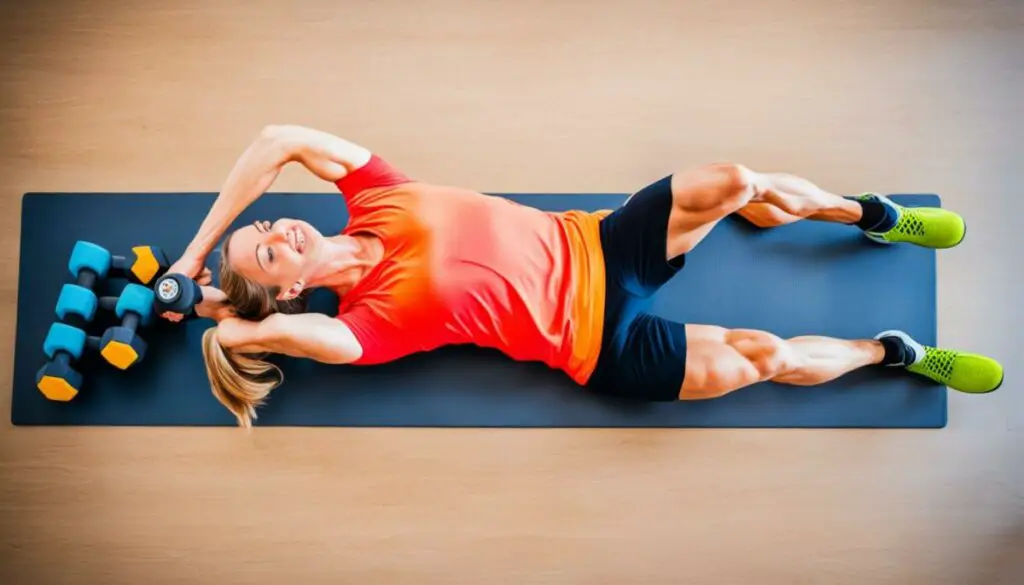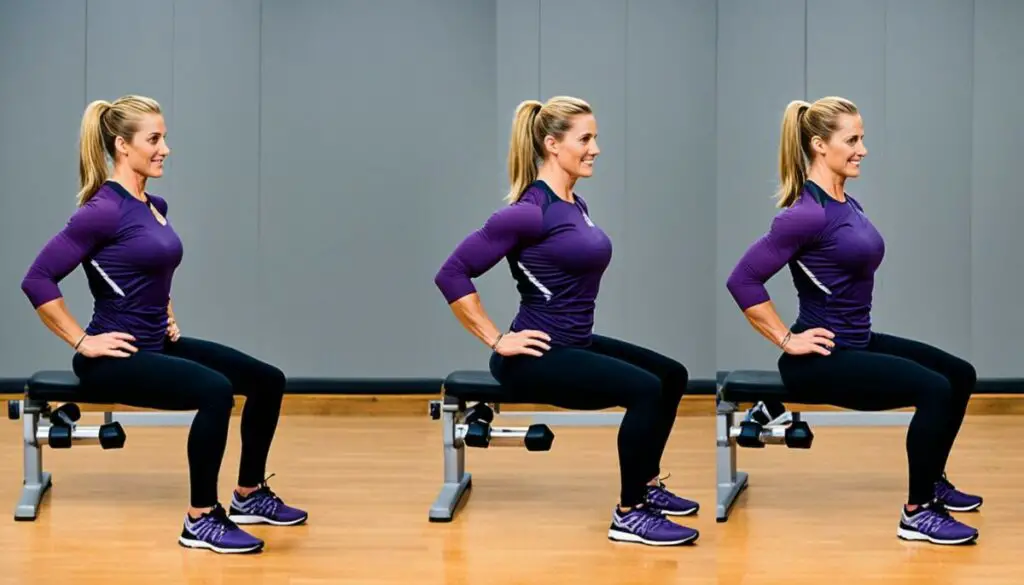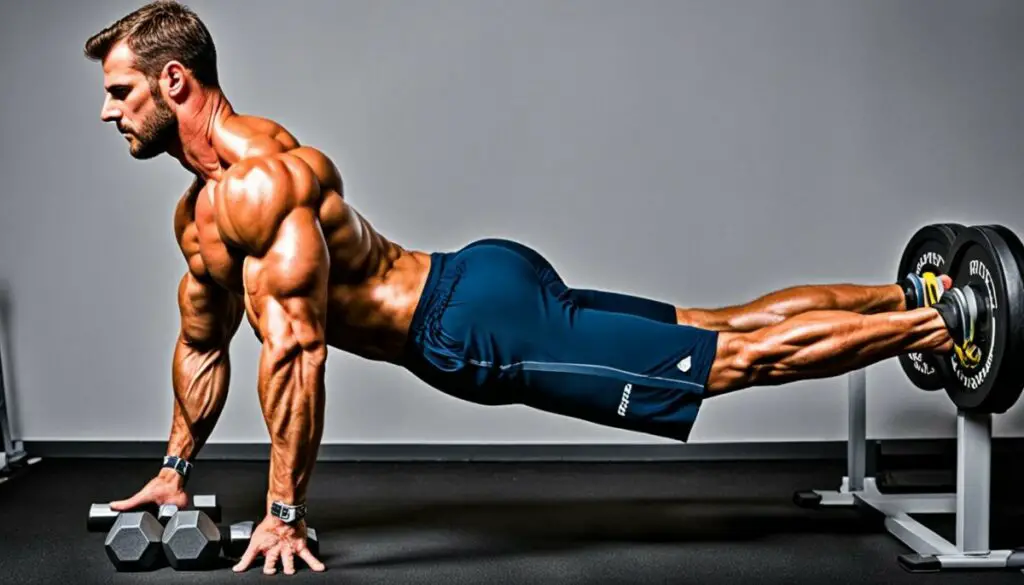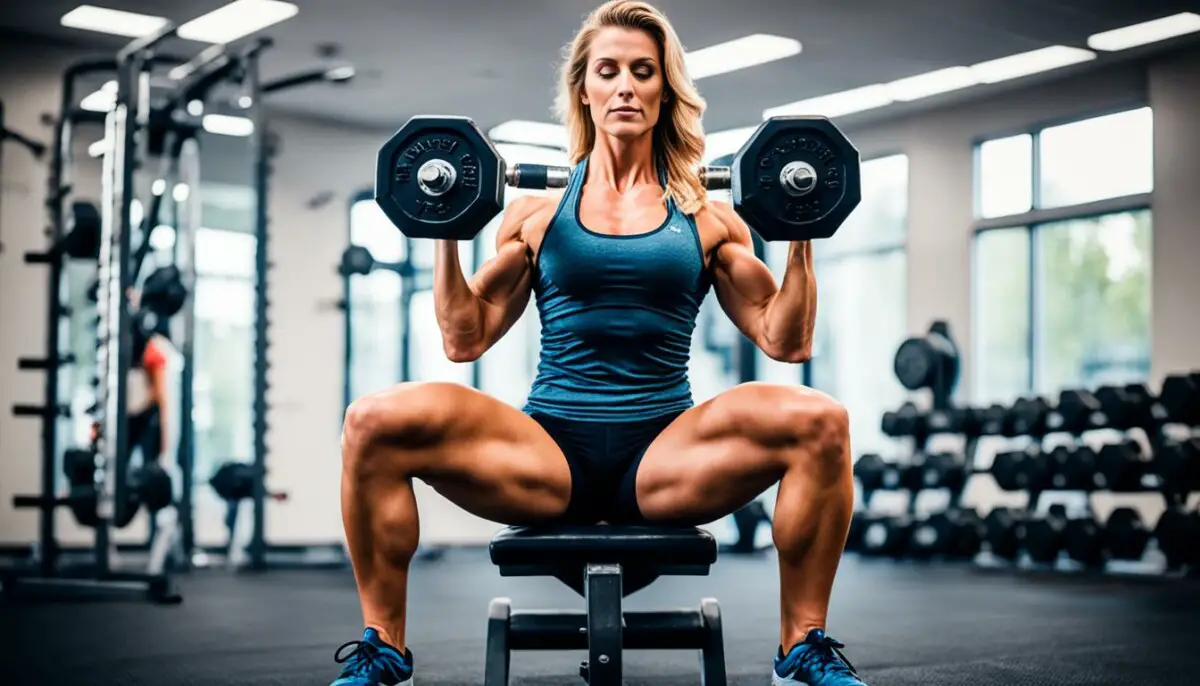Last Updated on 3 months by Francis
If you’re looking to strengthen your glutes and develop lower body strength, hip thrusts with dumbbells are a game-changer. This exercise specifically targets your glute muscles, helping you achieve a toned and sculpted posterior. Unlike traditional lower body exercises, hip thrusts isolate the glutes, giving them the focused attention they deserve. Whether you’re a beginner or an experienced fitness enthusiast, incorporating hip thrusts with dumbbells into your routine can supercharge your lower body workout.
Contents
Key Takeaways:
- Hip thrusts with dumbbells are an effective exercise for targeting the glute muscles.
- They can be customized for individuals of all fitness levels, from beginners to advanced.
- Proper form and technique are crucial for maximizing the benefits and preventing injuries.
- Hip thrusts with dumbbells can be modified and progressed to add variety and challenge to your workouts.
- Incorporating hip thrusts with dumbbells into your routine can contribute to a well-rounded and powerful lower body.
What is the Hip Thrust?

The hip thrust is a lower-body strength training exercise that targets the glute muscles, specifically the gluteus maximus. Similar to the glute bridge, the hip thrust involves hip extension and knee flexion. However, unlike the glute bridge, the hip thrust is performed with the feet on the floor and the back resting on a bench or elevated surface.
The primary focus of the hip thrust is to build lower body strength, particularly in the glutes. The exercise also engages the hamstrings and other glute muscles, contributing to overall lower body development and stability.
Whether using bodyweight or adding resistance with dumbbells, barbells, kettlebells, or resistance bands, the hip thrust can be adapted to suit different fitness levels and goals.
By incorporating the hip thrust into your workout routine, you can enhance your lower body strength, improve your glute activation, and boost your overall athletic performance.
Benefits of Hip Thrusts with Dumbbells

Hip thrusts with dumbbells offer numerous benefits for the lower body. They are highly effective for building glute strength and promoting muscle building in the glutes, which in turn can have a positive impact on overall posture and reduce the risk of injury and pain. Additionally, incorporating hip thrusts with dumbbells into your workout routine can enhance athletic performance by improving power and explosiveness in movements that involve the lower body.
One of the primary advantages of hip thrusts with dumbbells is their ability to target and engage the gluteus maximus, the largest muscle in the glutes. This muscle is responsible for hip extension and plays a key role in movements such as running, jumping, and squatting. By strengthening the gluteus maximus, hip thrusts with dumbbells contribute to a strong and functional posterior chain.
In addition to targeting the glutes, hip thrusts with dumbbells also engage other muscles in the lower body, including the hamstrings and adductors. These muscles work synergistically with the glutes, providing support and stability during movement. By strengthening these muscle groups, hip thrusts with dumbbells help to create a well-rounded lower body that is equipped for a variety of physical activities.
The core muscles also come into play during hip thrusts with dumbbells, as they assist in stabilizing the movement and maintaining proper form. A strong core is essential for optimal technique and ensures that the load is properly distributed throughout the body, reducing the risk of strain or injury.
Benefits of Hip Thrusts with Dumbbells:
- Promotes glute strength and muscle building
- Improves overall posture
- Reduces the risk of injury and pain
- Enhances athletic performance
- Targets gluteus maximus, hamstrings, adductors, and core
- Contributes to a balanced and functional posterior chain
Proper Form for Hip Thrusts with Dumbbells

Maintaining proper form is crucial for maximizing the benefits of hip thrusts with dumbbells. To ensure correct technique, it is important to keep a neutral spine by engaging the core and avoiding excessive arching in the lower back. By maintaining a neutral spine, you create a stable and strong base for the movement.
The movement during hip thrusts should primarily come from the hips and glutes, rather than from the lower back. As you lift your hips off the ground, focus on driving the movement through your hips, ensuring that your shoulders and knees are in alignment.
One key aspect of hip thrusts with dumbbells is glute activation. Squeezing your glutes at the top of the movement helps to maximize the activation and engagement of the target muscles. This contraction at the top of the movement also helps to develop greater strength and muscle growth in your glutes.
In summary, to perform hip thrusts with dumbbells with proper form:
- Engage your core to maintain a neutral spine
- Drive the movement through your hips and glutes
- Squeeze your glutes at the top of the movement for maximum activation
By following these guidelines, you can ensure that you are targeting the glute muscles effectively and minimizing the risk of injury during your hip thrusts with dumbbells.
Variations of Hip Thrusts with Dumbbells

Hip thrusts with dumbbells are a versatile exercise that can be customized according to your fitness level and goals. By incorporating various variations of this exercise into your workouts, you can continue challenging your muscles and promoting growth. Here are three effective variations to try:
1. Single-Leg Hip Thrusts
“Single-leg hip thrusts are a fantastic variation to intensify the glute activation and challenge your stability,” says fitness expert Jane Smith.
In this variation, you perform the hip thrust with one leg elevated off the ground. This requires greater muscle activation and balance, making it an excellent choice for advanced individuals seeking a more challenging workout. Single-leg hip thrusts can help correct muscle imbalances and develop unilateral strength.
2. Elevated Hip Thrusts
“Elevated hip thrusts target the glutes from a different angle and provide a greater range of motion,” explains strength coach Mark Johnson.
To perform elevated hip thrusts, place your upper back against a bench or box that’s at least knee height. Elevating your upper body allows for a deeper contraction of the glutes, maximizing muscle activation. This variation can be beneficial for individuals aiming to improve their hip thrust form or increase their overall strength.
3. Resistance Band Hip Thrusts
“Using a resistance band adds extra tension throughout the movement, boosting muscle activation and promoting hypertrophy,” states personal trainer Sarah Davis.
Resistance band hip thrusts involve placing a resistance band just above your knees or thighs. The band provides constant resistance throughout the exercise, intensifying the muscle engagement. This variation is suitable for beginners and advanced individuals alike and can help strengthen the glutes and improve hip stability.
Remember, when incorporating any variations into your workouts, it’s important to focus on maintaining proper form and technique. Start with lighter weights or less resistance and gradually increase the intensity as you become more comfortable and confident in your abilities.
By incorporating these variations into your hip thrust routine, you can ensure progressive overload and continuous muscle growth. Variety is key in keeping your workouts exciting and effective.
| Variation | Description | Benefits |
|---|---|---|
| Single-Leg Hip Thrusts | Perform hip thrusts with one leg elevated off the ground | – Increased glute activation – Improved stability – Targets unilateral strength |
| Elevated Hip Thrusts | Place upper back against a bench or box for a deeper range of motion | – Targets glutes from a different angle – Enhances glute contraction – Improves hip thrust form |
| Resistance Band Hip Thrusts | Use a resistance band just above the knees or thighs | – Increases muscle activation – Intensifies glute engagement – Improves hip stability |
Muscles Worked During Hip Thrusts with Dumbbells

Hip thrusts with dumbbells are an excellent exercise for targeting and strengthening specific muscle groups in the lower body. Let’s take a closer look at the muscles that are primarily engaged during this exercise.
1. Gluteus Maximus
The gluteus maximus, the largest muscle in the gluteal muscle group, is the primary target during hip thrusts with dumbbells. This muscle is responsible for hip extension, which is the main movement in the exercise. By performing hip thrusts with dumbbells, you can effectively activate and strengthen your gluteus maximus, helping to improve overall lower body strength and power.
2. Hamstrings
In addition to targeting the gluteus maximus, hip thrusts with dumbbells also engage the hamstrings muscles. The hamstrings, located on the back of the thighs, assist in hip extension and knee flexion during this exercise. By working the hamstrings along with the gluteus maximus, you can develop a balanced lower body and enhance your overall athletic performance.
3. Core Muscles
While the main focus of hip thrusts with dumbbells is on the glute muscles, the exercise also requires activation and stabilization of the core muscles. The core muscles, including the abdominals, obliques, and lower back muscles, play a crucial role in maintaining proper form and supporting the spine throughout the movement. By engaging your core during hip thrusts with dumbbells, you can improve overall stability and prevent injuries.
“Hip thrusts with dumbbells provide a targeted workout for the gluteus maximus, hamstrings, and core muscles, helping to strengthen and tone these important muscle groups.”
By incorporating hip thrusts with dumbbells into your lower body routine, you can effectively target and strengthen the gluteus maximus, engage the hamstrings, and activate your core muscles. This exercise is a highly efficient way to develop lower body strength and enhance your overall fitness level.
| Muscle Group | Primary Muscle | Secondary Muscles |
|---|---|---|
| Glutes | Gluteus Maximus | Gluteus Medius, Gluteus Minimus, Adductors |
| Hamstrings | – | – |
| Core | – | Abdominals, Obliques, Lower Back Muscles |
How to Do Hip Thrusts with Dumbbells
To perform hip thrusts with dumbbells, follow these exercise instructions for proper technique:
- Sit on a bench with your upper back against it and your feet flat on the floor.
- Place the dumbbells on your hips, just below the pelvis.
- Engage your core muscles and squeeze your glutes to flatten your lower back.
- Push through your heels, raising your hips until your body forms a straight line from shoulders to knees.
- Hold the position for a second, focusing on the mind-muscle connection.
- Slowly lower your hips back down to the starting position.
Maintain proper form throughout the exercise, emphasizing the mind-muscle connection between your glutes and hips. By following this hip thrust tutorial, you can ensure the effectiveness of the exercise and maximize your results.
The above image demonstrates the correct technique for performing hip thrusts with dumbbells.
Beginner’s Guide to Hip Thrusts with Dumbbells
If you’re new to hip thrusts with dumbbells, it’s important to start with proper technique and a suitable weight. This beginner’s guide will help you get started on your glute-building journey and ensure you maximize the benefits of this exercise.
Starting Out with Glute Exercises
Before diving into hip thrusts with dumbbells, it’s helpful to familiarize yourself with basic glute exercises to activate and engage your glute muscles. Bodyweight glute bridges and donkey kicks are great options to begin with. These exercises will help you establish a mind-muscle connection and ensure proper engagement of your glutes during hip thrusts.
“Starting with bodyweight exercises allows beginners to focus on technique and form before adding external resistance.”
Mastering the Hip Thrust Movement
Once you feel comfortable with the basic glute exercises, you can progress to bodyweight hip thrusts. This exercise is a precursor to hip thrusts with dumbbells and will help you develop the necessary strength and stability in your glutes.
To perform bodyweight hip thrusts, follow these steps:
- Start by sitting with your upper back against a bench and your feet flat on the floor.
- Place your hands on your hips and engage your core.
- Press through your heels to raise your hips off the ground, squeezing your glutes at the top.
- Lower your hips back down to the starting position.
Focus on maintaining a neutral spine throughout the movement and avoid excessive arching of the lower back. Proper form is crucial for effectively targeting the glutes and minimizing the risk of injury.
Gradually Adding Dumbbells
Once you have mastered bodyweight hip thrusts, you can start adding dumbbells to increase the resistance and further challenge your glute muscles. Begin with lighter weights and focus on maintaining correct form and technique.
Here’s how to perform hip thrusts with dumbbells:
- Set up the same as you would for bodyweight hip thrusts, with the dumbbells resting on your hips.
- Engage your core and squeeze your glutes as you press through your heels to raise your hips off the ground.
- Hold the contraction at the top for a second before easing back down.
“Progression is key when it comes to glute development. Gradually increasing the weight will help build strength and muscle in your glutes.”
Seeking Professional Guidance
As a beginner, it can be beneficial to consult with a personal trainer or fitness professional. They can assess your form, provide feedback, and guide you through proper technique when performing hip thrusts with dumbbells. Their expertise will ensure that you’re executing the exercise correctly and safely, minimizing the risk of injury.
Remember, everyone progresses at their own pace, so be patient and listen to your body. With consistency and proper form, hip thrusts with dumbbells will help you build a strong and sculpted posterior.
Conclusion
Incorporating hip thrusts with dumbbells into your lower body workout routine is a fantastic way to target and strengthen your glutes. These exercises provide a range of benefits, including improved posture, reduced risk of injuries, and enhanced athletic performance. By focusing on proper technique and gradually increasing the resistance, you can achieve a well-rounded and powerful lower body.
Whether you’re a beginner or at an advanced level, hip thrusts with dumbbells are suitable for individuals of all fitness levels. Starting with bodyweight hip thrusts and gradually adding dumbbells allows for progressive overload, promoting muscle growth and strength development in the glutes.
Remember to listen to your body’s feedback during your workouts. If you feel any discomfort or pain, adjust your form or consult with a fitness professional for guidance. By incorporating hip thrusts with dumbbells into your lower body routine, you can achieve your fitness goals and enjoy the benefits of increased glute strength.
FAQ
What are the benefits of hip thrusts with dumbbells?
Hip thrusts with dumbbells offer numerous benefits, including improved glute strength, enhanced posture, reduced risk of injury, and increased athletic performance.
How do hip thrusts with dumbbells target the glutes?
Hip thrusts with dumbbells primarily target the gluteus maximus, the largest glute muscle, while also engaging the hamstrings, adductors, and core muscles.
What is the proper form for hip thrusts with dumbbells?
To maintain proper form, engage your core, keep a neutral spine, and focus on the mind-muscle connection in your glutes. Avoid excessive arching in the lower back and ensure your shoulders and knees are aligned.
Are there different variations of hip thrusts with dumbbells?
Yes, you can modify hip thrusts with dumbbells by trying single-leg hip thrusts, elevated hip thrusts, or resistance band hip thrusts. These variations target the glutes from different angles and provide additional challenges.
How do I perform hip thrusts with dumbbells?
Start by sitting with your upper back against a bench and your feet flat on the floor. Place the dumbbells on your hips, engage your core, and squeeze your glutes as you raise your hips until your body forms a straight line from shoulders to knees. Lower back down and repeat.
Can beginners do hip thrusts with dumbbells?
Yes, beginners can start with bodyweight hip thrusts and gradually add dumbbells as they progress. It’s important to focus on proper technique and consult with a professional to ensure correct form and safety.








